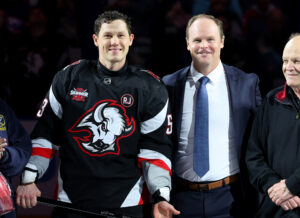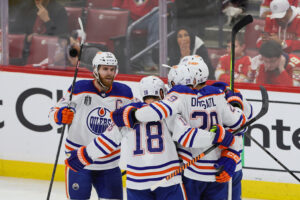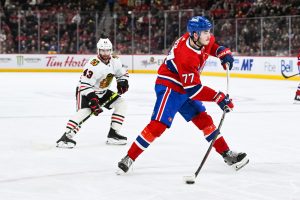In this paper, we use the principles and equations used in the film and book Moneyball. Also, discussing the application of “Moneyball” management to the hockey industry while, following the review of Moneyball and the use of sabermetrics in other sports, we attempt to apply similar practices to the sport of hockey. More specifically, we’ll apply it to the Los Angeles Kings roster.
Testing Out Moneyball with the Los Angeles Kings Roster
Introduction
Moneyball was essentially the use of sabermetrics (in hockey terms, advanced analytics) to construct and manage a team. This became popular with general manager Billy Beane of the Oakland Athletics in the early 2000s. From 2000-2007 the Athletics have compiled a 732-563 (.565) record, which was the 3rd best record in the American League and fifth-best in the MLB during that time.
Other MLB teams saw how effective it was to use undervalued players and analytical gems to construct a winning team. Not only did other MLB GMs try to apply this to their teams, but other leagues like the NBA and NFL tried to come up with their idea of using sabermetrics while building a team or lineup.
Former Detriot Red Wings GM Ken Holland stated, “We’re all trying to figure out how to get the best bang for our dollar…And, statistics can help that. But to me, hockey will never become a ‘Moneyball’ sport like baseball, because I think baseball is more of an individual sport, wrapped in a team game. t’s batter versus pitcher before every play, just two guys” Holland has a good point, and later went on to say, “We’ve got five guys on the ice that need to be in unison. What are the quality minutes, what are they like in the last few minutes of a game, when do they score the majority of their goals? In that sense, I think we are probably headed a bit toward ‘Moneyball’
But how could this be used in hockey?
After watching Moneyball the film I was inspired to come up with my own equations similar to Bill James’ equations. Also, trying to find those so-called “island of misfit toys” type players that Peter Brand talks about in the film Moneyball. Before we explain the metrics and equations used to find which players have the best value, we have to understand which metric can be used to determine a teams’ final ranking.
After little research and just thinking about it, we came up with goal differential, which may seem pretty obvious. The way you win hockey games is by scoring more goals than your opponent and allowing the fewest. That being said, I don’t think it’s fair to judge a player’s value based on the number of goals they scored, or how many goals the goaltender allowed. Players who receive more ice time technically have a bigger advantage over the players who receive less ice time. This leads to the whole point in this article, finding the players who are undervalued based on getting fewer ice time. Therefore, haven’t scored many goals to be “overlooked”
After applying this to the rebuild of the actual L.A. Kings, we found out there are some players in the league who actually create more scoring chances than someone who receives five to ten more minutes of ice time.
What models and equations were used?
So, let’s dive into it, shall we? This was most certainly not just plug one equation in and find out how much we could turn this Kings team around. It was a lot of trial and error, lots of failing.
Shooting Percentage
The first model I went with was a shooting model. Taking into account a player’s total goals scored and dividing it by his total number of shots, shooting percentage. I used shooting percentage for one of my player acquisitions. But trust me, he plays an important role to this newly designed Kings’ team.
Expected Goals Model
Taking a player’s G/60 and dividing it by 60 then multiplying it by the total amount of ice time the player received in the season would give you said player’s exact amount of goals.
Which can be used for an expected goals model. Taking a player’s xGF/60 and dividing it by 60 then multiplying it by the total amount of ice time the player received in the season would give you said player’s expected amount of goals. The xGF/60 stat takes into account the danger of the player. Where he shoots it from or how many plays he sets up that are “high danger” plays.
Using the expected goals model was most useful for finding guys who were creating lots of high danger opportunities for their teammates but were buried in the bottom six of their team. This ties back into the point of finding value in players that nobody else does.
This model was essentially our version of Moneyball’s runs created equation which was, (hits + walks) x total bases divided by at-bats + walks.
Expected Goals Against Model
This was most certainly the toughest of them all to figure out and apply to the team. So tough, I had to phone one of my good friends Matt Ludwig to help me out. Matt is an admin to hky_tapetalk on Instagram which is a hockey account highly focused on analytics.
I don’t want to completely get into it but essentially, to truly figure out a team’s expected goals against for the season you’d have to factor every defensive stat into one large model. Taking into account goaltending and overall defense from forwards and defenders.
For one of the goals against models, we used a three-season weighted average of Jonathan Quick, Cal Petersen, and Jimmy Howard (you will see Jimmy Howard‘s name appear later). That being said, Matt and I did apply more weight to the 2019-2020 season. Using Evolving Hockey’s advanced stats Matt came up with an equation that should look like this,
Weighted GSAx= (0.5) x (total 2019-2020 GSAx/gm) + (0.3) x (total 2018-2019 GSAx/gm) + (0.2) x (total 2017-2018 GSAx/gm). This would give you the Weighted GSAx for the Kings goaltenders.
Now, you also have to find the teams xGA/60 from 2019-2020 while finding each player’s RAPM xGA/60 and their time on ice. All from evolving hockey’s fantastic RAPM charts. Adding each player’s xGA/60 to the weighted GSAx should give you the team xGA/60.
To sum it all up, we used the lineup for the Kings 2021 opening night and scaled every player’s xGA/60 from their previous season to this year’s 56 game season.
Then we did the same thing with the newly shaped Kings team which I built. By the end of it, we had a rough estimate of how many goals the actual Kings 2021 team would allow and how many our 2021 Kings team would allow.
Win Percentage
Now for win percentage we actually used Moneyball’s win% equation which was, runs scored^2 divided by runs scored^2 + runs allowed^2.
In hockey terms, we just replaced runs scored with goals scored(GF) and runs allowed with goals allowed(GA) giving you GF^2 divided by GF^2 + GA^2.
The results
According to daily faceoff the Kings 2021 lines looked like this,
A.Iafallo – A.Kopitar – D.Brown
A.Athanasiou – B.Lizotte – J.Carter
A.Kempe – G.Vilardi – A.Wagner
T.Moore – M.Amadio – M.Luff
Defense
O.Maatta – D.Doughty
M.Anderson – M.Roy
K.MacDermid – S.Walker
Goalies
J.Quick
C.Petersen
Potential Kings lineup
Below is the Kings team we constructed based of models and equations which were listed above. All trades and signings can be found at our capfriendly custom roster builder.
Trades
- Jaret Anderson-Dolan
- Alex Iafallo
- 2021 4th round pick (CGY)
- Drew Doughty ($5,500,000 retained)
- Gabriel Vilardi
- Michael Anderson
- Akil Thomas
- 2022 2nd round pick (LAK)
- Neal Pionk
- 2023 4th round pick (WPG)
- Andreas Athanasiou
- Tobias Bjornfot
- Sean Walker
- 2022 6th round pick (DAL)
These where some of the biggest trades we made. The rest of the trades can be found here at our CapFriendly custom roster builder. Heres how the lines shaped up after all the trades and signings.
T.Meier – A.Kopitar – J.Bratt
A.Kempe – Q.Byfield – B.Coleman
R.Donato – C.Dvorak – Z.Sanford
B.Lizotte – J.Larsson – T.Ennis
Defense
O.Maatta – N.Pionk
B.Hutton – M.Roy
P.Nemeth – I.Lyubushkin
Goalies
J.Quick
C.Petersen
J.Howard
Would Moneyball work?
After applying the models and equations shown above, the normal 2021 L.A. Kings would approximately finish with 145 GF and have a 169 GA in the 56 game season. That would give them a win percentage of .424 and likely finish 25th-31st in the NHL.
Our 2021 Kings team would finish 15th in the NHL in GF with 172 and finish 3rd in the NHL in GA with 142. Likely finishing the 56 game season in the 9th-12th range in the NHL.
To find out these results we took each team’s GF and GA from the 2019-2020 season and scaled it to a 56 game season. Now I realize that some teams had dramatic roster turnovers and their 2020 team is a lot different than their 2021 team, so give or take a few on these final standings.
But taking into account some other models, JFresh’s terrific work also projects a significant improvement for this Los Angeles Kings roster, relative to the Kings’ current lineup. His pre-season work had the Kings scoring 52 points across 56 games, good for 30th in the league. With the Moneyball-version of the Los Angeles Kings roster, though, they would be projected to net 68 points, tied for seventh in the league.
In terms of money, we saved just under $1,000,000 for a total cap hit of $ 70,754,058 as opposed to the actual $71,325,283
Final thoughts
This was an attempt to find value in players where some NHL teams might not and see how they would preform on the team. Which was exactly what the film and book Moneyball was about. And it resulted in some serious improvements for the Los Angeles Kings roster.
Now you have to take this with a grain of salt so to speak, do I think the Kings should basically trade away their entire roster plus prospects and future picks for some system that was used in the MLB and not the NHL? No, but it would be interesting to see how this team would really do in real life. Well maybe they should do this…
Furthermore, you would also have to factor in line chemistry and most likely make a coaching change upfront for a coach that would fit this defensive scheme. Also, the willingness for a player with an NMC or NTC to waive those in order to be traded.
That being said, this could be something that would work if you signed these guys in free agency rather than trading for them.
I realize half the comments will be about my trades, but leave a comment down below or tweet us @LastWordOnPuck and let us know what you think. What do you agree/disagree with? Would Moneyball work in the NHL?
(All Data and Information via Evolving-Hockey & Hockey-Reference)
Main Photo:






